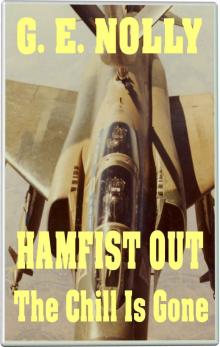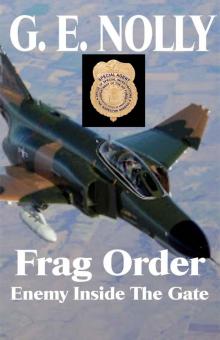- Home
- G. E. Nolly
Radiant Crossing: Trouble On Black Friday (The Adventures of Hamilton Hamfist Hancock Book 5)
Radiant Crossing: Trouble On Black Friday (The Adventures of Hamilton Hamfist Hancock Book 5) Read online
Radiant Crossing
Trouble On Black Friday
By
G. E. Nolly
This book is a work of fiction. Names, characters, places and incidents are either the product of the author's imagination or are used fictionally. Any resemblance to actual persons, living or dead, or to actual events or locales is entirely coincidental.
This ebook is licensed for your personal enjoyment only. This ebook may not be re-sold or given away to other people. If you like to share this book with another person, please purchase an additional copy for each person you share it with.
Copyright © 2013 G. E. Nolly . All rights reserved. Including the right to reproduce this book or portions thereof, in any form. No part of this text may be reproduced in any form without the express written permission of the author.
Version 2013.03.16
This book is dedicated to American military veterans, past, present, and future.
1
November 28, 2013
2013 Greenwich Mean Time
West 30 Degrees
Flight Level 310
I had just drifted off to sleep, with the rhythmic undulations of the aircraft gently rocking me to sleep, when there was a loud knock on the bunk door. Calling the claustrophobic space a bunk was a stretch, but at least it provided the opportunity to get a power nap while my two copilots manned the cockpit. I opened the door and swung my legs to the aisle floor, being careful not to completely sit up so I wouldn’t hit my head on the bottom of the upper bunk.
I blinked against the light in the narrow hallway between the passenger cabin and the cockpit as I let my eyes adjust. Bill Burton, our Purser, was standing in the hallway.
“Captain Hancock, the crew called me to wake you. You’re needed in the cockpit immediately.”
“Thanks, Bill. Could you please send up a coffee, black with Splenda?”
“Right away, sir.”
My mind raced to clear the cobwebs as I tried to envision what the problem was. I could fully appreciate what the Captain of Air France 447 must have experienced, as he was awakened from his crew rest and rushed to the cockpit as his airplane was falling out of the sky. Two minutes later, he was dead, along with everyone else on his plane.
But this was different. Unlike Air France 447, we were operating in daylight hours. At night, every emergency is at least twice as difficult to handle. More important, we were in a Boeing 777, not the Airbus 340 that Air France 447 flew. Every time I thought of 447, I muttered to myself, “If it ain’t Boeing, I ain’t going”.
I entered the cockpit access code into the keypad on the door lock and waited for the crew to unlock the fortified door. Mary, the First Class Flight Attendant, had arrived behind me with a Styrofoam cup of coffee. I took a quick sip, and the fog instantly started to clear from my mind. Obviously, my degree of sleepiness or wakefulness was totally psychological.
Jim Johnson, the copilot assigned to the left seat, peered through the viewport and opened the door. I swiftly entered.
“What’s up, guys?”
“Sir, we’re having a lot of different problems,” said Mark Mason, my other copilot. “They all happened at the same time, about ten minutes ago. And they all seem unrelated.”
“Okay,” I replied, “let’s go over them one by one. What’s the most serious?”
“ Well,” Jim answered, “we lost our GPS positioning. Both of them.”
That was unusual. Really unusual. The 777 has enough redundancy in its systems that if one component fails, another will pick up the slack. I’d been flying the 777 for over ten years, and never had a Global Position System fail. The odds against both failing were astronomical.
But it wasn’t that big a deal, really. The Flight Management Computers on the airplane would simply compute our present position, groundspeed and wind vector from the Inertial Reference Units. The IRUs were much more accurate than the Inertial Navigation Systems like we had in the older airplanes. An INS will get you position accuracy within a few miles after a 10-hour flight like ours, while an IRU will get you within a hundred feet. And once we were over land, instead of the middle of the Atlantic Ocean where we presently were, the FMC would use land-based navigation transmitters, VORs, to update our position.
My copilots were too young to remember when we didn’t have “glass” cockpits, with moving-map displays and GPS positioning. During our layover in London, when we’d been doing some “hangar flying” at the hotel bar, they’d confided to me that they’d never flown anything but glass. Even their basic flight training airplanes had glass instruments. Using old-fashion round dials, like I’d been flying with for most of my forty-year career, would be an emergency procedure for them.
“Okay,” I responded, “not that big a problem. What else?”
“ At 30 west we couldn’t get CPDLC to work, and we’ve been unable to raise Gander on either HF or VHF.”
“Did you try the left, right and center radios for both VHF and HF?” I asked.
“Yes,sir,” Jim responded,. “tried them all. Nothing.”
That could be a problem, but not a show-stopper. The Controller-Pilot Data Link Communications System was the airborne equivalent of sending emails back and forth between aircraft and Air Traffic Control. CPDLC made it much easier to talk to ATC than trying to make contact on the radio through static and interference from other aircraft transmissions. Our fallback communications method would be what we used back in the old days – voice transmissions on the radio, using either HF or VHF. It was really unusual for both radio systems, with their triple redundancy, to be inoperative.
Fortunately, the weather was severe clear. I looked ahead and could see an Air Canada 767 a thousand feet below us, slightly ahead, our speeds perfectly matched. Well ahead I could see contrails, those white trails that form when an aircraft disturbs the air and causes ice crystals to form, that indicated where we would be flying next. All aircraft on North Atlantic routes, called NAT Tracks, flew on assigned flight paths at specifically-assigned speeds. There were additional tracks every thirty miles north and south of our route.
I could see the other aircraft on our Traffic Collision and Avoidance System, called TCAS, and everyone seemed to be on course with no problems.
“Have you tried 12345?” I asked.
“Not yet,” Jim answered, “We thought we’d get your input before we went outside our airplane.”
That was a good call. It could have been something as simple as a couple of popped circuit breakers, and there was no reason to tell the world yet. I instinctively glanced at the overhead circuit breaker panel. None were tripped. I moved my transmitter selector to the right VHF radio, which was tuned to the oceanic inter-plane frequency of 123.45 megahertz.
“This is WorldJet Airways 407 on 12345. Is anybody up on frequency?”
“Hello, WorldJet Airways, this is Air Canada 332, a bit past 30 west. We’re having problems contacting Gander on any of their frequencies, and we’ve lost our GPS. And our SATCOM isn’t working also. Are you having the same problems?”
“That’s affirmative,” I answered, “We have no comm with our company on ACARS also.”
The Arinc Communication and Reporting System was an automatic data link with our company headquarters. Theoretically, we could maintain communications with our company anywhere in the world with either ACARS or the Satellite Communications system. When Air Canada mentioned SATCOM, Mark pointed at the Satellite Communications control panel and gave me a thumbs down s
ignal.
“Same here.”
“WorldJet Airways and Air Canada, this is Delta 883. We’re about sixty miles ahead of you. Did you hear US Air’s transmission?”
“Delta, this is WorldJet Airways 407. Negative. Would you relay for us?”
“Roger, WorldJet Airways. US Air said that the word is being passed along that there’s been an EMP attack. No one is in contact with ATC, and we’re all pretty much on our own.”
An Electro Magnetic Pulse attack, the detonation of a nuclear weapon at high altitude over the United Airways States, could wipe out the entire power grid of the country in the blink of an eye. There’d been stories about the Iranians planning something like that, and the subject had been in the news recently when Boeing had announced that they had developed a drone that could do the same thing to an enemy on a more local scale. But something about the EMP attack story didn’t sound quite right.
“Wait a minute, guys,” I transmitted, “an EMP attack wouldn’t knock out our GPS satellites. I think it might be something else, like sun spot activity.”
“This is Delta 883. You’re right, WorldJet Airways. I’ll pass this up ahead and see if anyone has any more information.”
I heard Delta relay my message, then I heard an intermittent, scratchy retransmission from an airplane ahead of him. Maybe one of the planes ahead of us would get more information. We had our own airplane to worry about.
“Jim, do you have the WBM?”
“Here you go, boss.”
I looked at all five pages of the Weather Briefing Message. It was like I always said: I’d rather be lucky than good. Severe clear weather over the entire eastern half of the United States, from Colorado east, for the next two days. A winter storm was predicted in a couple of days, but right now it was smooth sailing. This was great news. If the power grid was out, there was no telling if the backup systems at all the airports would be operational. We may have navigation signals, we may not. At least it was daytime, and the weather was good. We’d be able to make a visual approach to wherever we were going to land.
Chicago O’Hare Airport, our destination, was always hectic, even when communications were working. Even on a good day when everything was going smoothly, the ATC controllers usually sounded more like tobacco auctioneers than tower operators. If there was any snag in communications, it was going to get pretty hairy.
I looked at the O’Hare forecast. The wind was going to be from the west. At an airport that’s not very busy, that would most likely mean landing to the west. At O’Hare, unless the wind was greater than 10 knots, takeoff and landing directions were not so set in stone. My guess was that we’d be using Runway 32 Left, 32 Right, 27 Left or 27 Right. Depended on which runway they were using for takeoffs.
But wait. If communications were out, there wouldn’t be any takeoffs. Only landings. That meant our potential conflicts had just been cut in half. Things were starting to look up. I turned to Jim and Mark.
“Okay, guys, I think there’s been some kind of event that’s taken out most of the radios and the power grid. Is anything else on the airplane inop?”
“The only other thing I noticed is the EFBs aren’t working,” Jim said. “I think they quit around the same time as the GPS.”
I looked down at my Electronic Flight Bag. The screen was black, unpowered. Unlike when we carried 40 or 50 pounds of paper charts and maps in our “brain bags”, the leather catalog cases pilots had carried since the beginning of commercial aviation, all of our flight documents were now in our EFBs, with backup copies in the iPads we’d recently been authorized to use in the cockpit.
I looked on the overhead circuit breaker panel and found the EFB-L and EFB-R circuit breakers and pulled them out. One potato, two potato, three potato. I pushed them back in. It would take a few minutes to see if recycling the breakers would get the Left and Right EFBs back in operation.
“Jim,” I said, “check your iPad. We may need to use the charts in there.”
“Bad news, Ham,” he answered. “I tried cranking it up a few minutes ago, and all I got was a black screen with the Apple logo. I tried both of the others, too, and none of them are working.”
“Hamilton,” Mark said, “why would some of our equipment work and some not?”
“Most of our electronics,” I answered, “are in the lower electronics bay. That area is well shielded, and the airplane itself acts pretty much like a Faraday cage. The electronics in the cockpit, like the iPads, aren’t so well protected because of all of the windows. My guess, and it’s just a guess, is that there was some form of event, like a sun spot, that caused a glitch. When we get closer to land, within radio range of the States, we’ll try Guard frequency. I suspect that Guard transmitters have some sort of power backup, and they’re probably well shielded. We’ll just have to wait.”
Mark and Jim silently nodded. After about three minutes, the EFBs came back to life. At least we’d have our charts. It was going to be at least three more hours before we were within range of any American or Canadian radio stations.
It was going to be a long three hours.
2
November 28, 2013
2346 Greenwich Mean Time
West 60 Degrees
Flight Level 310
It was time to give ATC a call on Guard frequency. We were still over the ocean, but, I estimated, we would be in range of one of the radio facilities on the east coast.
For the previous three hours we had maintained a listening watch on VHF 123.45, and had passed along our information, sparse as it was, to aircraft following us. If this had been a domestic flight, we would have come into contact with aircraft that were headed east, but the NAT tracks only operate in one direction. Flights on the tracks go east at night, usually to arrive in Europe around the time the airport control towers accept arrivals, typically 0600 local time, like Heathrow. Westbound flights operate in the daytime.
From what I could determine, all of the airplanes I had made contact with had exactly the same indications we had, in terms of inoperative equipment. Fortunately, our TCAS was working, since it was dependent only on the operability of onboard equipment. That meant we would be able to visualize nearby aircraft on our TCAS display, and we would all be able to maneuver to avoid midair collisions with other TCAS-equipped aircraft. At these high altitudes, all aircraft were required to have TCAS. It might be a different story altogether when we got lower, as we approached to land, since light planes didn’t usually have that equipment. But I suspected there wouldn’t be any light planes flying by the time we got to Chicago.
We had a fairly lengthy discussion about exactly where we should land. Given that the meteorological conditions were virtually the same everywhere, arrival weather would likely not be a factor. There was the real potential that, wherever we went, we might not get a gate at the terminal. That would mean remote parking.
The problem with remote parking was that we might not be able to get off the airplane. The 777 sits so high that it takes a special loading bridge or portable stairs to reach up to the aircraft door sill. If we were to divert to an airport that didn’t routinely accept 777s, we could have a problem with our passengers trapped onboard.
That’s what happened when I was flying a trip on September 11, 2001. Like today, weather was crisp and clear all over the United States. When the national aviation emergency was declared, every aircraft was told to land immediately at the nearest airport.
At the time, I had only been a 777 Captain for two years. Two years may sound like a long time, but the 777 is a highly sophisticated airplane, and it takes quite a bit of time for a pilot to fill his bag of tricks on a new airplane. I was flying a domestic trip, from Washington Dulles Airport to Denver International Airport. We were over Kansas when the national emergency was declared. It seemed like a no-brainer to me to continue to Denver, but when the controllers said land immediately, they meant immediately. The closest small blue circle on my cockpit moving map display, denoting a suitable airpor
t, was labeled “KFOE”. From my Boeing 727 days, when I had flown nothing but domestic trips all over the country, I had remembered that FOE was the VOR identifier for Topeka.
With some great help from my copilot, I had scrambled to program Topeka into our FMC to enable the pressurization system to schedule properly, located the paper approach charts for Topeka that I carried in my “brain bag”, the catalog case that carried all of my documents, and set up for an immediate landing. As I extended the speed brakes and executed an emergency descent, my copilot had made a quick Passenger Address announcement advising everyone on the aircraft that we were making an emergency landing at Topeka.
When we landed at Topeka, the Ground controller advised us that the loading bridges could not accept any aircraft larger than a 727, so we would have to deplane remotely. Then they told us that the only portable stairs they had would be three feet short of our door sill. I still remembered, now eleven years later, how I had stood on the top step of the portable stairs and helped the passengers deplane, one by one. We had three wheelchair passengers that day. It was grim.
I wasn’t going to let that happen again today, if I could help it. The passengers already were aware that something was wrong. About a half hour after the glitch happened, the purser came up to the cockpit.
“Captain, is there something going on that I need to know about? One of our passengers noticed that our airplane symbol isn’t moving on the Airshow moving map display on the passenger video screens. He did a pretty good impression of Scotty from Star Trek when he said, ‘They have us in a tractor beam.’ Anything wrong besides the Airshow?”
“We’re not sure, Bill. We’ve lost contact with our GPS satellites, and with all ground-based communications facilities. We’re hearing from other airplanes that the power grid is out all across the United States. Right now, we’re planning on continuing on to O’Hare, but that’s subject to change. I’ll keep you posted as soon as I hear anything new. I’ll make a PA announcement to let the folks know what little I know.”

 Radiant Crossing
Radiant Crossing Radiant Crossing: Trouble On Black Friday (The Adventures of Hamilton Hamfist Hancock Book 5)
Radiant Crossing: Trouble On Black Friday (The Adventures of Hamilton Hamfist Hancock Book 5) Hamfist Out: The Chill Is Gone (The Air Combat Adventures of Hamilton Hamfist Hancock Book 4)
Hamfist Out: The Chill Is Gone (The Air Combat Adventures of Hamilton Hamfist Hancock Book 4) Frag Order: Enemy Inside The Gate
Frag Order: Enemy Inside The Gate Hamfist Over Hanoi: Wolfpack on the Prowl (The Air Combat Adventures of Hamilton Hamfist Hancock Book 4)
Hamfist Over Hanoi: Wolfpack on the Prowl (The Air Combat Adventures of Hamilton Hamfist Hancock Book 4)